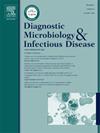Global impact of hMPV virus: Transmission, pathogenesis, diagnostic and treatment
IF 2.1
4区 医学
Q3 INFECTIOUS DISEASES
Diagnostic microbiology and infectious disease
Pub Date : 2025-03-18
DOI:10.1016/j.diagmicrobio.2025.116809
引用次数: 0
Abstract
The Human Metapneumovirus (hMPV), a member of the Pneumovirinae subfamily, is a substantial cause of acute lower respiratory infections, notably in young children, the elderly, and immunocompromised patients. It was first identified in 2001, hMPV has displayed a seasonal pattern of infection, with symptoms ranging from moderate to severe respiratory disease. This study investigates the worldwide effect of hMPV, concentrating on its transmission, etiology, diagnostics, and treatment techniques, underlining the need for better public health measures. hMPV is spread by respiratory droplets, with a normal incubation period of 3–5 days. The virus induces an immune response characterized by pro-inflammatory cytokines, leading to respiratory symptoms and probable tissue damage. Diagnostic breakthroughs, including RT-qPCR and mNGS, have enhanced detection sensitivity. However, therapy is generally supportive, with potential breakthroughs in mRNA vaccines targeting hMPV fusion proteins. Current clinical studies evaluate the effectiveness and safety of these new vaccinations, which might pave the road for effective prevention.
Despite tremendous gains in understanding hMPV, there remains a crucial need for targeted antiviral treatments and vaccines to minimize its worldwide health impact.

hMPV病毒的全球影响:传播、发病机制、诊断和治疗
人偏肺病毒(hMPV)是肺病毒亚家族的一员,是急性下呼吸道感染的主要原因,特别是在幼儿、老年人和免疫功能低下患者中。hMPV于2001年首次发现,表现出季节性感染模式,症状从中度到重度呼吸道疾病不等。本研究调查了人乳头状瘤病毒的全球影响,重点关注其传播、病因、诊断和治疗技术,强调需要采取更好的公共卫生措施。hMPV通过呼吸道飞沫传播,正常潜伏期为3-5天。该病毒诱导以促炎细胞因子为特征的免疫反应,导致呼吸道症状和可能的组织损伤。包括RT-qPCR和mNGS在内的诊断突破提高了检测灵敏度。然而,治疗通常是支持性的,针对hMPV融合蛋白的mRNA疫苗有可能取得突破。目前的临床研究评估了这些新疫苗的有效性和安全性,这可能为有效预防铺平道路。尽管在了解hMPV方面取得了巨大进展,但仍然迫切需要有针对性的抗病毒治疗和疫苗,以尽量减少其对全球健康的影响。
本文章由计算机程序翻译,如有差异,请以英文原文为准。
求助全文
约1分钟内获得全文
求助全文
来源期刊
CiteScore
5.30
自引率
3.40%
发文量
149
审稿时长
56 days
期刊介绍:
Diagnostic Microbiology and Infectious Disease keeps you informed of the latest developments in clinical microbiology and the diagnosis and treatment of infectious diseases. Packed with rigorously peer-reviewed articles and studies in bacteriology, immunology, immunoserology, infectious diseases, mycology, parasitology, and virology, the journal examines new procedures, unusual cases, controversial issues, and important new literature. Diagnostic Microbiology and Infectious Disease distinguished independent editorial board, consisting of experts from many medical specialties, ensures you extensive and authoritative coverage.

 求助内容:
求助内容: 应助结果提醒方式:
应助结果提醒方式:


